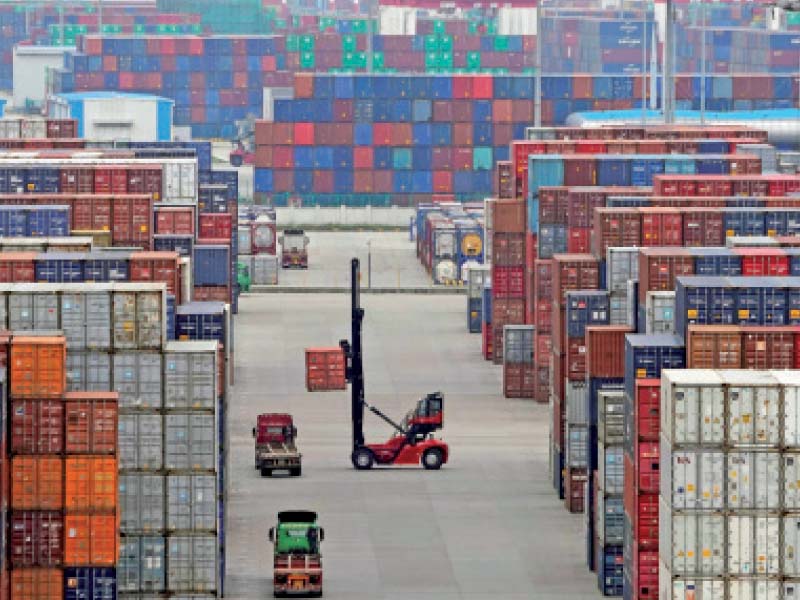
The numbers on the trade pattern published by the Pakistan Bureau of Statistics (PBS) for July 2020 indicate a significant reversal of the trend in prior months.
Exports surpassed $2 billion, a month-on-month increase of 25.1% and year-on-year growth of 6.1%. On the other hand, imports decreased slightly, month-on-month and year-on-year. The balance of trade continued its downward trend, receding by 19.9% month-on-month and 7.7% year-on-year.
Pakistan has recovered from the earlier plunge in exports experienced in late March 2020. Exports in February 2020 were $2.1 billion, the highest level reported for FY20. Interestingly, imports did increase 30% in June 2020 to $3.7 billion over the value reported in May 2020. They maintained this level in July 2020.
On the other hand, India’s exports recovered sharply in May 2020 from the sharp fall in April but since then the trajectory has been flatter.
Data shows India’s exports stood at $19.1 billion in May 2020, up from $10.4 billion in April. Exports in July 2020 were $23.6 billion. Exports had peaked at $27.7 billion in February 2020.
Imports into India were calculated at $41.1 billion in January 2020, which decreased to $17.1 billion in April 2020 and recovered to $28.5 billion in July 2020.
Similarly, according to data extracted from Bangladesh’s Export Promotion Bureau, a decline of 16.9% was reported in its total exports from July 2019 to June 2020 over the same period of previous year. Total exports met only 74% of the target. Exports of readymade garments were a major casualty.
Factors that may have contributed to the quick recovery in exports from Pakistan were the easing of the strict lockdown imposed in March 2020 that allowed exporters to restart work and meet their export demand as well as the incentives provided by the government to the exporters to recuperate their losses borne during the lockdown.
Pakistan's customs dept to give maximum import, export facilities
Although it may be too early to determine the direct impact of each individual measure to counter the losses due to Covid-19, the measures adopted by the government have collectively increased exports and averted an impending economic disaster predicted by several experts in earlier days of the lockdown.
Policy responses
Our World in Data is an excellent repository for the latest data on not only the trend and indicators to measure the spread of Covid-19 across the world but also on the policy responses adopted by countries since the start of the pandemic.
The dataset provides a stringency index for government response that weighs different types of closures such as schools, workplaces and travel bans.
Pakistan, India and Bangladesh adopted stringent measures to counter the spread of the virus in the second week of March 2020. By the third week of March, the three countries were in a complete lockdown.
The three countries then started easing the restrictions in mid-April. By early June, the lockdown was significantly eased across the three countries. However, by mid-August, Pakistan had relaxed its restrictions more than its regional counterparts.
Pakistan, India and Bangladesh have continued to maintain school closures, however, Islamabad has gradually relaxed restrictions on workplace closures, public gatherings and transport. This easing of restrictions has likely benefitted export-oriented industries as well as the related supply chains.
The ease in the lockdown, accompanied with incentives to lower losses, has likely propelled exports.
Central bank measures
The State Bank of Pakistan (SBP) has taken several measures to counter the adverse impact of Covid-19 on Pakistan’s economy.
Apart from reducing the policy rate by 625 basis points in three months since March 2020, it approved the refinancing of wages to prevent layoffs worth Rs138 billion for 2,200 businesses by late July 2020.
Furthermore, Rs640 billion was provided till mid-August 2020 in the form of deferred payments of the principal amount of loans as part of the debt restructuring offered to households and businesses.
Exporters were provided relief under the Export Financing Scheme (EFS) and the Long-Term Financing Facility (LTFF). Furthermore, financing of Rs21 billion was approved to facilitate new investments across all sectors of the economy.
Imports fall, but export growth still a challenge in Pakistan
The State Bank also issued Rs992 billion worth of fresh currency notes to banks across Pakistan for circulation.
The biggest increase in exports in July 2020 over July 2019, as reported by the PBS, was in textile products and leather manufactures.
Shipments of textile products increased by 14.4% in dollar terms while those of leather manufactures rose by 33.8%. Knitwear exports increased by 20.4%, bedwear 25.3%, towels 21.4% and readymade garments 18.04%. Exports of leather gloves increased by 56.8% and of leather garments by 17.4%.
On the other hand, Pakistan reported a decline of 15.5% in exports of food products. Exports of rice declined by 23.5% while zero exports of wheat and sugar were reported.
However, exports of fish and fish preparations increased by 53.6%. PBS also reported a surge in exports of petroleum products.
Although imports were 0.7% lower in July 2020 compared to imports in July 2019, the imports of food products were higher by a walloping 82.1%.
Imports of dry fruits increased by more than six times while imports of palm oil and sugar rose by 189% and 125.9% respectively.
Imports of the machinery group decreased but imports of power generating machinery increased by 27.3%. There was also a revival in imports of completely built units (both of motor cars and buses) as they increased by 196.7%.
Imports of petroleum products decreased by 24.9% as oil prices fell. Unfortunately, imports of textile machinery decreased by 33.9%. This lack of replacement and upgrading is a matter of concern and poses a challenge to sustainability in the revival of exports from the textile industry.
In essence, the rate of recovery in exports of Pakistan was rather unexpected. The challenge now is to ensure that such growth rates are sustainable.
It is essential to ensure that exporters are not only facilitated through improved processes and procedures but a right set of incentives are provided to businesses to further boost export sales and tap the new opportunities emerging in the wake of Covid-19.
The writer is the Assistant Professor of Economics & Research Fellow at CBER, IBA
Published in The Express Tribune, August 24th, 2020.
Like Business on Facebook, follow @TribuneBiz on Twitter to stay informed and join in the conversation.




1732184775-0/BeFunky-collage-(80)1732184775-0-165x106.webp)













COMMENTS
Comments are moderated and generally will be posted if they are on-topic and not abusive.
For more information, please see our Comments FAQ